This comprehensive guide will showcase the 13 easiest fish for your home aquarium! Not only that, we also provide resources to help you keep these 13 low maintenance aquatic pets in optimal conditions. Check it out!

Once you learn the ropes about aquarium upkeep, everything else gradually falls into place, and the hobby doesn’t seem like a daunting task anymore. Part of this is knowing what are the easiest fish you could take care of in a medium-sized aquarium or a smaller bowl.
Some fish types require extra care but not everyone has the time to monitor their aquatic pet around the clock.
It helps if the chosen fish species are hardy enough to thrive with limited care and are able to overcome little mistakes such as forgetting to turn on the filter after feeding.
That’s why, for beginners, a low upkeep pet fish is always the best choice, and I advise you not to overlook this if you are just starting.
Typically, such fish species are most livebearers, some plecos, and an order of fish known as Labyrinth fish or Anabantiformes like Bettas and some Gouramis.
Whether you are going for the tropical freshwater fish or the cold water species, you can always find the type that does not require constant monitoring.
But are there ones that you can look after without the need for a filter?
Let me show you if there’s a low maintenance approach, and what are the easiest freshwater aquarium fish to take care of.
Quick Sidenote: Do you want to watch this article instead of reading it? Checkout the highlight video below from our YouTube Channel (Or read the more detailed article below), be sure to Subscribe For More Great Fishkeeping Content:
13 of the Easiest Fish to Take Care of in a Low Upkeep Aquarium
I have compiled a list of what I consider to be pet fish that are very easy to take care of because they require minimal monitoring.
Generally, these are species that are not easily affected by slight changes in the aquarium’s water parameters.
That being said, here are the 13 easiest fish that you could take care of:
1. Siamese Fighting Fish – Betta splendens

| Maximum Size: | around 2.7 inches (6.8 cm) but there are reports of it reaching up to 3 (7.6 cm) |
| Suggested Fish Tank Size: | 3 gallons as a bare minimum but preferably 5 or more |
| Suggested Water Temperature: | 75°F to 82°F (24 to 28 Celcius) |
| Suggested pH range: | 6.4 to 7.4 |
The Siamese Fighting Fish are members of the large and well-known Betta genus.
As the very name suggests, Betta fish are born-fighters; they start to fight as soon as they are born, or so it seems.
Unfortunately for them, this fighter mindset means a Betta fish is best kept alone if you’re new to the hobby. Though keeping one among other aquarium companions is possible, it is not a recommended setup for beginners.
Anyway, these tropical fish seem to like interacting with humans, or rather, my particular Betta likes interacting with me whenever I feed him.
When I get close to the fish tank, he will come out of his hiding to curiously inspect me.
Betta fish are small enough for an aquarium of 3 gallons to be able to temporarily accommodate a single specimen. However, the best Betta fish tank size is 5 gallons as this species likes to slowly explore its surroundings.
Bettas suit the beginners, most of who start with a small fish tank. Another reason the Betta is widely considered an easy kind of pet fish to take care of is that it is somewhat hardy.
Sometimes, however, people may over-stretch how resilient a Betta fish really is.
Fish stores oversimplify this fish’s hardiness by selling it in tiny confined jars.
Betta fish can indeed survive severe conditions, including smaller fish tanks that are low on oxygen, because they swim to the surface to gulp in the air directly from the surface.
This is thanks to their unique labyrinth lungs, which allows them to breathe atmospheric air. For this reason, some people do not see the need for a filter in an aquarium with a Betta fish.
I would not advise you to buy into that mindset but the point is that Betta fish is one of the easiest fish you can ever take care of.
Make sure you give yours enough space for swimming since these fish are curious explorers.
Betta fish would also need hideaways, which are easily achievable with the help of a couple of live aquatic plants.
Don’t let that put you off, because there are some cool aquatic plants that require almost no care at all, besides having the right aquarium light (hint: LED lights are your best bet).
The Java Fern and the Java Moss need nothing more than basic care and can be used to create dense aquatic vegetation in a fish tank.
You could also go with floaters: The Dwarf Water Lettuce is one of the best floating plants to put in a Betta aquarium, among other options.
Another thing to consider is finding a beautiful piece of driftwood, that will give this natural look to the tank and will also provide exploration areas for your Betta.
Anyway, aside from having the right aquarium decoration, make sure the fish tank’s not filled to the brim with water so that the fish can take its oxygen when needed.
If you consider keeping a Betta fish as a pet, take a look at this guide for proper Betta aquariums.
These aquarium kits are beginner-friendly and come with almost all the needed equipment to start (except a heater).
Recommended by Aquanswers: 4 Top Water Heaters for Small Aquariums of between 3 and 10 gallons
The aquarium gear I suggest for a single Betta fish in a 5-gallon tank:
- To grow lush aquarium plants that will provide the resting and hiding spots your Betta needs, check out the Finnex FugeRay Planted Plus.
- For a proper filtration in your small Betta tank I recommend this sponge filter together with this air pump and this airline tubing.
- To heat such a small aquarium, I suggest using the FREESEA water heater with LED display.
Author’s Note: Check out our post on the The Top 10 Most Popular Betta Fish for even more beautiful Betta varieties!
2. Blue-Eyed Spotted Rainbowfish – Pseudomugil gertrudae

| Maximum Size: | 1.5 inches (3.8 cm) |
| Suggested Tank Size: | 15 gallons for a school of 6 companions. |
| Suggested Water Temperature: | 72 to 84°F (22 to 29°C) |
| Suggested pH range: | 4.0 to 8.0 |
If you have a planted tank and are looking for a peaceful, hardy fish, then go for the Blue-Eyed Spotted Rainbowfish.
Coming from the Pseudomugil genus they are native to regions with thick aquatic vegetation.
These fish enjoy the shade provided by floating aquarium plants in home conditions, under which they form schools.
A planted fish tank thus reminds them of their natural habitat and makes them feel comfortable. These tropical schooling fish need to be kept in small groups because they need to form a social hierarchy.
The Blue-Eyed Spotted Rainbowfish is a fantastic low-maintenance fish and a school of a couple of specimens could be enough for your new freshwater planted aquarium. The Blue-eyed Spotted Rainbowfish are easy to take care of and will be just fine, once you provide them with a dependable aquarium filter.
The fish is not just peaceful but also too timid to fight over food so if you have more aggressive fish in the aquarium, your Blue Eye Spotted Rainbowfish might be taken advantage of and outdone at meals.
These fish have beautiful coloration, which gets more intense and pronounced in larger schools. In fact, they made it to my list of super colorful freshwater fish.
They also remain small throughout their lives, growing to a maximum of about 1.5 inches.
You can comfortably keep a school of Blue-Eyed Spotted Rainbowfish in a 10 to 15-gallon fish tank with live plants.
Here’s the aquarium gear suggested for a 15-gallon tank with 6 Blue-Eyed Spotted Rainbowfish:
- For growing thriving aquarium plants in your Blue-Eyed Spotted Rainbowfish aquarium, I recommend using the Finnex FugeRay Planted Plus LED lights.
- For maintaining tropical water temperatures in the tank, I will recommend the 100-Watt Cobalt Aquatics Neo-Therm aquarium heater.I like this heater for various reasons, but mostly because it has super cool design and its great at keeping a stable temperature in my tanks. Check out which online store has a better offer on it, while you’re at it – Amazon is usually a good choice.
- When it comes to the filtration of a 15-gallon tank, my opinion is you’ll need a realiable canister filter, such as the Eheim 2213. This canister filter will do a perfect job of maintaining clean water in your Blue-Eyed Spotted Rainbowfish aquarium.
Author’s Note: Check out our post on The 12 Types of Freshwater Rainbowfish for A guide to colorful aquatic gems!
3. Lambchop Rasbora – Trigonostigma espei

| Maximum Size: | Typically stays at around 1 inch of body length but some specimens are known to reach 1.5 inches (2.5 to 3.8 cm) |
| Suggested Tank Size: | 10 or more gallons if you’re a beginner |
| Suggested Water Temperature: | 73 to 82°F (23 to 28°C) |
| Suggested pH range: | 5.5 to 7.5, but anything under 7.5 will do |
Coming from the Trigonostigma genus, the Lambchop Rasbora is a small freshwater fish that closely resembles the more popular Harlequin Rasbora in looks.
However, I’ve found that the Lambchop one has more vivid and better-pronounced colors.
Anyway, this species can be really easy to look after as long as two conditions are met:
- Your tap water is not hard;
- You have a 10-gallon or a larger tank.
Let me explain.
The Lambchop Rasbora fish do not require very soft water, but they do come from a habitat that’s a little on the softer end.
The right water pH is somewhat important for the longevity of these fish. If your tap water is not hard, then you should likely be fine.
As to requiring a 10-gallon tank or larger: at this volume and size, there’s more room for error when it comes to water quality.
Lambchop Rasboras are hardy, but they do appreciate stable water quality.
Author’s note: You can keep Lambchop Rasboras in a 5-gallon tank, for example, but you’d need to make sure the water parameters remain stable. If you’re a beginner in the hobby I would recommend getting the larger tank.
A 10-gallon tank can safely accommodate 10 to 12 Lambchop Rasboras.
I actually recommend going with this number, because these fish feel more confident in a larger school.
Anyway, the Lambchop Rasbora is an omnivore and not at all picky when it comes to food.
They will readily accept fish flakes and other commercial foods.
One final tip I can give for taking care of these fish is to have floating plants in their tank.
This way the tank will mimic the dimly lit habitat of the Lambchop Rasboras.
Having floating plants in the tank will give even more confidence to the fish, which in turn makes their behavior super entertaining.
4. Red Wagtail Platy – Xiphophorus maculatus
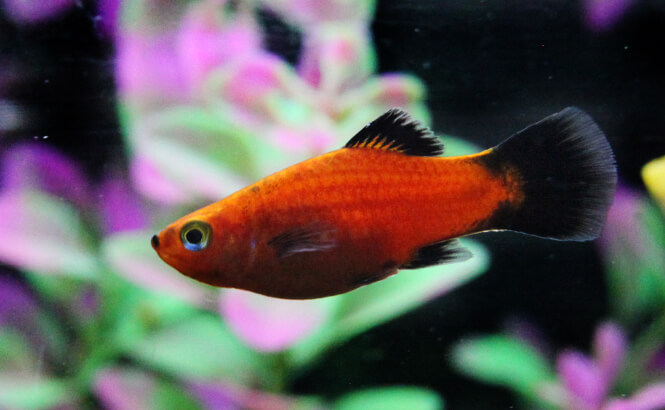
| Maximum Size: | 2 inches (5 cm) |
| Suggested Tank Size: | at least 10 gallons |
| Suggested Water Temperature: | 73 to 77°F (22.7 to 25°C) |
| Suggested pH range: | 7.1 to 8.1 |
The Red Wagtail Platy is hardy enough to be one of the easiest freshwater aquarium fish to take care of if you’re a beginner.
All it requires are the basics: clean water with a warm temperature because they are tropical fish, a stable Ph reading, enough space to wander about in the aquarium, and food.
Fortunately, they seem to eat anything and I do consider them to be the ultimate fish-pigs.
Note that you should not put them into your fish tank until it is through with the initial nitrogen cycle since wagtail platies would rather die than adjust fast enough.
The point is, although they are hardy enough to remain healthy in tough water conditions, they require stability with no major fluctuations.
Red Wagtail platies, members of the Xiphophorus genus, are suitable for a community tank because they never harass their tank mates.
To learn about more about great community fish like the Red Wagtail Platy, click here. By the way, I like Wagtail Platies’ appearance and temper so much that I also listed them in my list of the most cool-looking freshwater fish to keep at home.
Anyway, platyfish tend to over-breed, giving birth to live fry almost every month.
A pregnant platy fish that’s going to give birth soon will swim at the fish tank bottom most of the time.
If you want to raise the fry, feed them crushed flakes.
Also, separate the babies from the mother immediately after birth to save them from being eaten.
To avoid all of this you could just get a group of 3 or more single-sex platyfish. It would probably be best to get females only.
5. White Cloud Mountain Minnow (WCMM) – Tanichthys albonubes
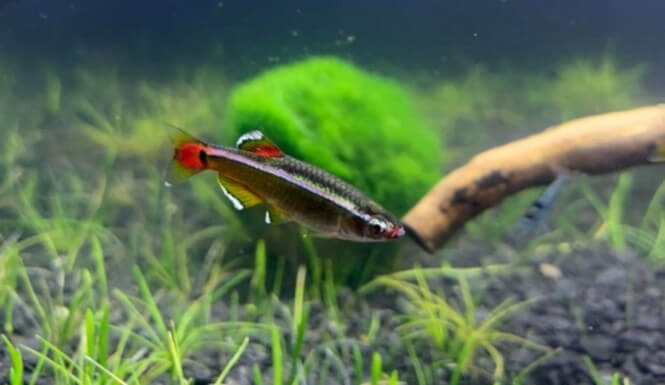
| Maximum Size: | 1.4 inches or roughly 3.6 centimeters |
| Suggested Tank Size: | 10 gallons is suggested as a minimum |
| Suggested Water Temperature: | 59 to 71°F (15 to 22°C) |
| Suggested pH range: | 6.5 to 8.5 |
The White Cloud Mountain Minnow is yet another hardy species you should consider keeping if you are looking for a freshwater fish that require low maintenance.
These hardy aquarium pet fish within the Tanichthys genus have the ability to adapt to a wide range of temperatures or harsh conditions.
Being a cold-water fish, the White Cloud Mountain Minnows can comfortably carry on in an aquarium even if it has no water heater.
The water temperature might fall as low as 5°C or 41°F, but the minnows would survive.
As you can see, they are excellent survivors. I once read a report elsewhere that they can survive a deadly Fin Rot epidemic which normally wipes out the rest of the aquarium fish.
A temperature range of between 59 and 71°F or 15 and 22°C is actually beneficial for their life span and immune response.
I should also let you know that they are excellent jumpers, so make sure your fish tank’s top is under a lid.
They jump high when they are sad and even higher when they are intimidated.
Author’s Note: Check out our post on The White Cloud Mountain Minnow for an in-depth guide to these beautiful fish!
6. Neon Tetra – Paracheirodon innesi
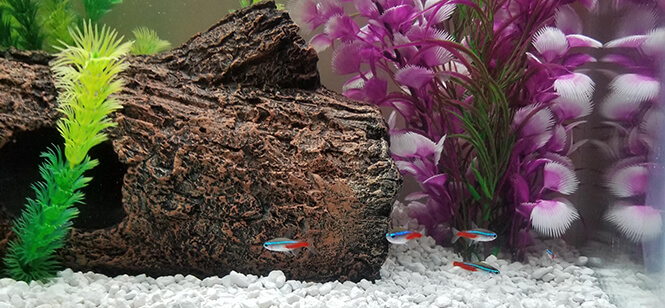
| Maximum Size: | 1.4 inches at most (3.5 cm) |
| Suggested Tank Size: | 10 gallons for a school of 6 to 7 neon tetras |
| Suggested Water Temperature: | 71 to 78°F (21.5 to 25°C) |
| Suggested pH range: | 5.8 to 6.8 |
The Neon tetras are truly hardy tropical pet fish a beginner should not miss in his aquarium.
These freshwater fish come from the Paracheirodon genus, the species of which we refer to as tetras.
But not everyone agrees that Neon Tetras should be among the easiest fish to look after.
To some fish-keepers, they are too delicate to pass for a hardy fish. My experience with them shows the following:
Neon Tetras are hardy aquarium fish as long as they are not exposed to inconsistent temperatures or unstable water parameters.
Once an aquarium is biologically mature and stable, Neon tetras will establish themselves and you will keep them alive with ease.
There are those fish keepers who assume that if a fish is hardy, it means it should be placed in any aquarium and left to survive.
Surely, even hardcore criminals are not thrown in jail and left on their own.
The point being – you still have to check the water parameters and do the necessary aquarium cleaning from time to time.
There is one difficult thing about Neon tetras and that’s making them lay fertilized eggs. However breeding any aquarium fish should come after you’ve read on and gained some experience with the species in question, so there’s that.
Anyway, Neon Tetras are widely known to be peaceful, though at times they may become aggressive when stressed or threatened.
Do not confine them in a small fish tank with little room for shoaling.
Though these fish are tiny they are active swimmers and need the distance.
If you’re on the look for freshwater fish or invertebrates that can comfortably live in a 5-gallon tank you should check this list of ideas.
Anyway, I recommend a 10-gallon or a 20-gallon Long aquarium for keeping Neon Tetras.
These aquariums have the needed space that the Tetras would need to freely roam about.
Neon Tetras are quite timid when there are bigger fish in the aquarium, so keeping them in a low-lit environment helps boost their confidence.
7. Zebra Danios – Danio rerio
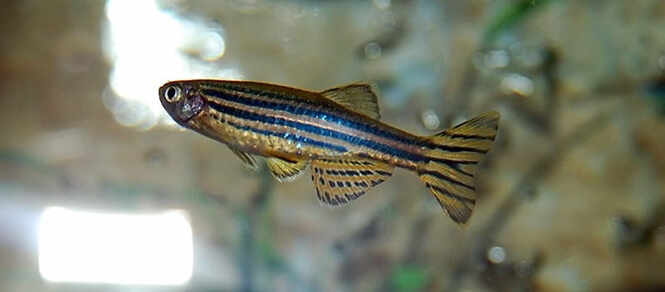
| Maximum Size: | 2.2 inches (5.6 cm) but rarely some reach 2.5 (6.3 cm) |
| Suggested Tank Size: | 20 gallons for a school of 7 to 8 specimens |
| Suggested Water Temperature: | 64 to 76°F (or between 17.7°C and up to 25°C) |
| Suggested pH range: | 6.5 to 8.2 |
Certain aquarium fish varieties would not survive an aquarium that’s going through cycling, a prolonged power outage or the occasional skipped meal.
But rarely will these affect the Zebras Danios.
The Zebras Danios are one of the members composing the Danio genus.
They suit new fish tanks and it’s fun watching them swim to the top, where they love to stay in a group, chasing one another playfully.
If you get at least a school of 6, they will shoal peacefully, ignoring even the filter currents that may scare away other types of more lethargic fish.
They let other tank mates shoal with them as well.
I’ve personally seen them swim together with White Cloud Mountain Minnows in the same aquarium but the Zebra Danios will let any other schooling fish join them.
They have lovely colors that you may not have a good look at since the fish dart back and forth too frequently for your eyes to follow.
This is not common but it does happen if the danio school is not large enough.
You should aim to keep a group of at least 6 members to eliminate the possibility of aggression.
Zebra Danios are comparatively good parents in that they rarely feast on their own fry or eggs.
Feed these fish flakes, supplemented with the occasional bloodworm or brine shrimp.
8. Harlequin Rasboras – Trigonostigma heteromorpha
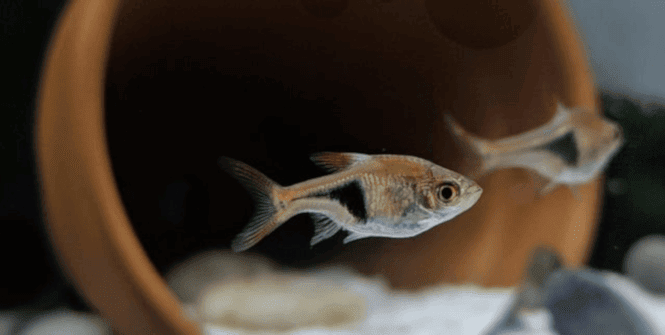
| Maximum Size: | around 2 inches which equals 5 cm |
| Suggested Tank Size: | 10+ Gallons |
| Suggested Water Temperature: | 70.7 to 84.2 °F (between 21.5 and 29 °C) |
| Suggested pH range: | 5.8 to 7.7 |
Harlequin Rasboras and their relatives the Lambchop Rasboras, mentioned above are members of the same genus known as Trigonostigma.
It is easy to spot Harlequin Rasboras from a distance thanks to the black marker that runs through their rear.
The blackness stands out especially because it contrasts the fish’s metallic coloration that shines beautifully in the light.
It is therefore fun watching a school of these vibrant fish swim through the upper sections of the aquarium’s water column.
It helps if you keep 8 or 10 of them to make their shoaling more entertaining.
Aside from their appearance, the main reason why many upcoming fish-keepers find Harlequin Rasboras irresistible is that these fish are quite easy to look after. Simply set up stable water parameters, keep the fish tank clean and maintain a simple diet.
Another reason these freshwater fish are popular has to do with their size.
Being so tiny, you can actually keep about 6 of these nano fish in a 10-gallon aquarium.
But I would advise that you go for a larger fish tank of, say, 20 gallons, which will work better and give them more room for shoaling.
They are also peaceful and usually coexist with many equally non-aggressive fish tank mates.
Unfortunately being peaceful and small in a community tank means some larger fish see them as an easy target for bullying, so be careful which larger fish you introduce in this aquarium setup.
Finally, they are easy to keep because they eat both plants and flesh so you are under no restrictions when it comes to providing them food.
Harlequin rasboras are also the nano fish that are the easiest to breed.
During the mating season, they don’t require anything more than clean aquarium water and regular feeding.
However, do make sure to give them their favorite dishes, not just anything you think of.
Insect eggs are some of their beloved delicacies.
9. Pepper Corydora – Corydoras paleatus
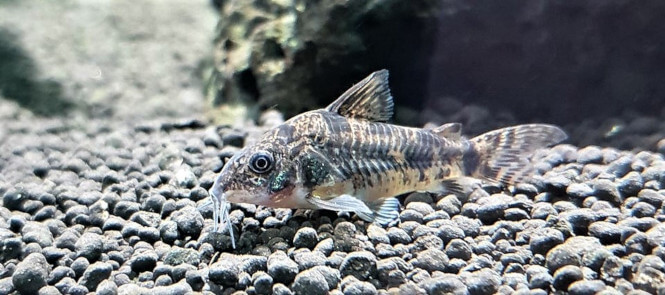
| Maximum Size: | 2.8 inches or 7.1 cm but most will remain at 2.5 inches which is 6.4 cm |
| Suggested Tank Size: | 10 Gallons as a minimum |
| Suggested Water Temperature: | between 72 and 79°F (22.2 to 26.1°C) |
| Suggested pH range: | 6.2 to 7.2 |
A seasoned aquarist once confided in me that any fish store without any type of Cory Catfish is not worth its name.
There are over 175 species of Cory fish, and I believe many are still being discovered.
Pepper Corydoras is just one of the many out there.
The Corydoras Catfish may come in different types, but one thing they have in common is that they are hardy and easy to care for. Many beginners prefer to have them as aquarium pets for this reason.
Pepper Corydoras are no exception to the aforementioned rule.
Also known as blue leopard corydoras, the peppered cory is one of the well-known corydoras species from the Corydoras genus in the hobby.
Like many of its cousins, it is hardy, and one of the reasons is that they possess the same labyrinth organ as Bettas.
Their intestinal lining enables them to suck in oxygen directly from the air so they can comfortably live in the low-oxygen waters.
It should be noted that this is true as long as the fish tank is not full to the top if it has a lid.
Another reason pepper corydoras are easy to look after is that they maintain stunted growths when kept in a fish tank, somehow an adaptation they develop to fit in.
The Pepper Corydoras are one of the most peaceful fish you will find around the pet store.
They swim around calmly in groups, troubling no tank mate.
If you have only two, you will notice that they never stay away from each other no matter what.
It becomes even more entertaining if you keep five or six of them. They are also nicknamed “bottom cleaners” because they spend their time mainly at the tank bottom of the fish tank, hunting for scraps.
They may, however, swim to the surface when they see food up there or to breathe.
Don’t let them survive purely on leftovers merely because I said they are “bottom cleaners” though.
Also, ensure the substrate is free of sharp materials since Pepper Corydoras do have very sensitive whiskers and bellies that could be pierced or cut by rough sand.
Author’s Note: Check out our post on The 14 Best Types of Corydoras Catfish for A guide to these hardy and playful freshwater fish!
10. Jack Dempsey Cichlid – Rocio octofasciata
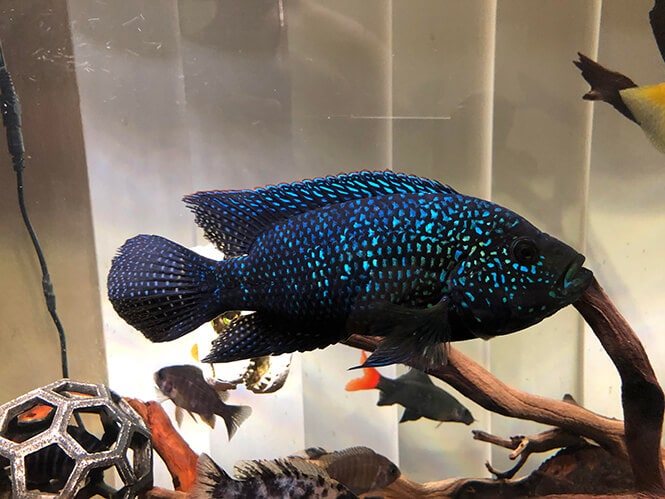
| Maximum Size: | 10 inches (25.4 cm) |
| Suggested Tank Size: | At least 55 gallons for one fish. |
| Suggested Water Temperature: | 74 to 81°F (23 to 28°C) |
| Suggested pH range: | 6.5 to 8.5 |
The following entry is the most “advanced” fish on this list but it still falls within the rule for requiring easy care.
This South American cichlid fish is named after Jack Dempsey, who was an internationally-acclaimed heavyweight boxing star known especially for his ruthless attacks.
That is an assurance that this fish is nowhere near peaceful and has the potential to turn a community fish tank into a boxing ring.
The more this fish loses its temper, the more it turns dark, you can imagine how the timid fish in your tank will feel at such a time.
That said, I have to point out that the Jack Dempsey cichlid is a magnificent fish. Apart from their beauty, they are easy to keep, and that’s one more reason many beginners can’t afford to ignore them.
On the other hand, they may be fighters, but at least they love their children.
The Jack Dempsey cichlids protect their fry and go as far as pre-chewing food for them.
As a Cichlid coming from South America, these fish assigned to the Rocio genus are carnivorous.
However, they rarely eat their fry, which is rather uncommon.
In case they do, it means they have been disturbed, stressed or something is seriously wrong with the aquarium’s water parameters.
However, they eat any other fish that fit well into their mouths. Don’t worry about its diet though, I wrote a guide where you can discover some good Cichlid food options (check entry #7 for Jack Dempsey Cichlid food).
Anyway, these fish are territorial, so I advise that you decorate your aquarium with caves, which the Jack Dempsey fish can mark as territories.
Break lines of sight so that they may not see one another from their territories.
This helps minimize their aggressive tendencies.
Although aggressive, at times they get shy and want to hide.
That’s rather absurd, yet another reason you need hideaways like the caves for them.
I should also add that they are hardly aggressive with themselves and they only intimidate other fish mostly, so you can keep them in their own single species fish tank if possible.
11. Red Swordtail – Xiphophorus hellerii
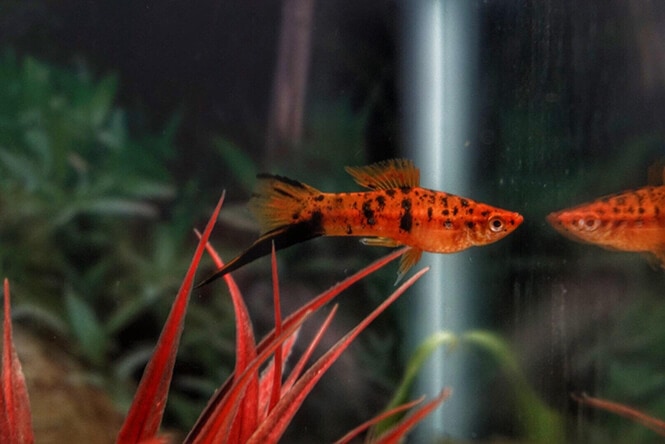
| Maximum Size: | 4.2 inches or 10.6 cm with the outcrop tail for a mature specimen |
| Suggested Tank Size: | 20+ gallons as a bare minimum |
| Suggested Water Temperature: | 71 to 77°F (21 to 25°С) |
| Suggested pH range: | 6.5 to 7.5 |
The red Swordtail fish is a community tank fish for it is typically peaceful, social, and timid.
Same the Red Wagtail Platy, the Red Swordtail belongs to the Xiphophorus genus.
Though at times it may lose its temper and turn aggressive towards other fish and even against each other this happens very rarely.
This is especially true among the males, but I must stress again that it is rare.
Anyway, when they are themselves, angelfish, platys, and mollies are some of their favorite tank-mates.
Swordtail fish like staying in groups and enjoying one another’s company although they do not shoal.
The red swordtail is as hardy as hard can be and it can survive in environments that other fish might consider unfriendly the least.
Being omnivorous, swordtails also eat a wide variety of food which makes caring for them very easy.
Or should I perhaps say they eat virtually anything, from mosquito larvae, bloodworms, fruit flies, flake food, bloodworms to algae…
Many advise that for every one male red swordtail fish, you should keep at least two females.
My personal experience with these pet fish agrees with that statement.
If the females’ ratio is lower, the insatiable males would exhaust them.
The male has a long outgrowth springing from the lower point of the tail.
It is after this sword-like outcrop that the fish got its name.
12. King Tiger Plecostomus – Hypancistrus sp.
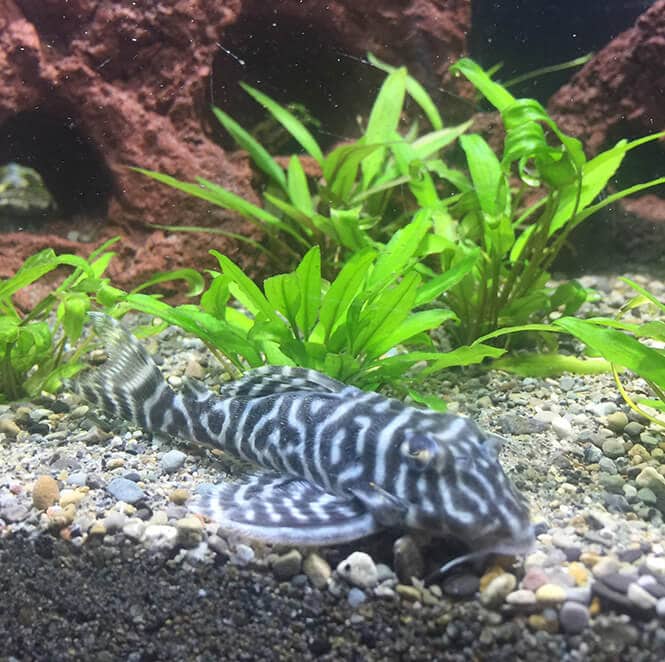
| Maximum Size: | 6 inches or 15.2 cm |
| Suggested Tank Size: | 55 gallons |
| Suggested Water Temperature: | between 77 and 83°F (between 25 and 28.3°C) |
| Suggested pH range: | 5.5 to 6.8 |
With its brown stripes that spread throughout its body and even on the eyes and the tail, the King Tiger Pleco is one of the most gorgeous pet fish an aquarist can get.
A King Tiger Plecostomus requires low maintenance, and that’s why they are suitable for most beginners. It may resemble the jungle tiger in looks but not in mannerisms as it is peaceful, preferring to claim territories in the aquarium’s bottom where it can enjoy some quietness.
Although it is generally friendly, it does wage war against its brothers as they compete for territory.
However, once they have marked their boundaries, all is well, unless one willfully trespasses.
Provide them with hiding places but not too many aquatic plants if you wish to mimic their natural habitat.
The King Tiger pleco from the small Hypancistrus genus comes from a natural habitat known for fast-current waters, so a robust filter is not going to scare it off.
While it is an exceptionally hardy fish, the King Tiger Pleco needs high levels of oxygen.
It also suits a large fish tank of at least 55 gallons of water capacity, considering that it can grow up to 6 inches in body size.
Also Read: Small Pleco Species That May Be Suitable for Beginners
King Tiger Plecos are nocturnal, so it helps if you feed them at night.
With everything else in place, the King Tiger Pleco is one of the easiest freshwater fish a beginner with a larger aquarium should wish to take care of.
Author’s Note: see also The 14 Best Small Pleco Species (Under 4.3″ in Adult Size) for more small plecos!
13. Kuhli Loach – Pangio kuhlii

| Maximum Size: | 4 inches (10.1 cm) |
| Suggested Fish Tank Size: | 20 gallons for juveniles and 125 gallons for adult specimens |
| Suggested Water Temperature: | 76 to 86°F (24.5 to 30°C) |
| Suggested pH range: | 6.0 – 7.8 |
If none of the listed species has quenched your desire for the bizarre, then the Kuhli Loach (Pangio kuhlii) surely will.
At first glance, these oddballs look nothing like fish due to their serpent-like body.
And since their body is also covered in alternating stripes, you’re more likely to confuse them for a water snake.
Once you spend enough time around them, however, you’ll realize they embody the fish spirit all the way through.
If they’re provided with plenty of space, Kuhli Loaches will shed their shy persona and become playful explorers.
You can even expect them to occasionally inspect the floating plants at the top of your water column.
Which is quite rare for a bottom dwelling species.
To bring out the true nature of Kuhli Loaches, you’ll need to keep them in groups of at least three. Even though they’re not exactly schooling fish, they’ll feel more comfortable around their own. Additionally, you’ll also want to furnish their home with driftwood, plants and caves.
This way, they’ll have more than enough places to hide if they feel stressed.
Even though they come from soft waters, Kuhli Loaches can tolerate water with a pH up to 7.8.
Since they’re a tropical species, they need warm water with a temperature between 76 and 86°F.
Apart from their hardiness, Kuhli Loaches are also extremely peaceful which makes them great for beginners.
The only thing you should be careful about is their whiskers.
They’re extremely sensitive and can easily get damaged on rough substrates or sharp decor.
To prevent this, simply use sand or any other smooth substrate, and you won’t have any trouble.
Caution: Despite their bottom-dwelling nature, Kuhli Loaches might try to jump out of the aquarium if they’re kept without a lid.
Author’s Note: Check out our post on The Kuhli Loach: A Fascinating Nocturnal Bottom-Dweller Demystified for an in-depth guide to these great aquatic pets!
What to Pick For a Smaller Bowl?
Not every would-be fish-keeper has adequate space for an aquarium or the time to care for it.
Keeping a fish in a bowl is the only viable option at times, but not every fish is suited to live in such a confined space.
So here is what to look for in the easiest fish to care for in a bowl:
A fishbowl is usually small, meaning the water surface area is not wide enough, in relation to the volume ratio, to guarantee an adequate gaseous exchange. A fish that’s easy to take care of in a bowl should, therefore, be able to thrive on a limited oxygen supply.
Betta fish, which has a unique organ called the Labyrinth, is one kind of fish that can survive such low-oxygen environments. The labyrinth helps with breathing atmospheric air which allows the Betta to gulp in oxygen directly from the water surface.
Any fishbowl with a capacity of under 3 gallons is not recommended for keeping live fish.
Such small volumes of water get polluted by organic waste very quickly and sudden ammonia spikes, deadly for aquatic inhabitants, are often observed.
A 5-gallon bowl with some live plants would make a good habitat for a single male Betta.
To check some more fish that remain small in size even in their adult stage of life you can click here.
What’s A Good Choice For A Small 10-Gallon Aquarium?
If you have the required space at home, it is usually best to get an aquarium with at least 10 gallons of water capacity.
Have a look at the easy fish to look after in a 10-gallon fish tank:
The Betta fish would be a suitable candidate for an aquarium with 10 gallons of water capacity because this species remains small to its adult life and is hardy. Blue eye spotted Rainbowfish, harlequin rasboras, or a school of 6 to 7 neon tetras are other choices that can carry on well in a small 10-gallon fish tank with live plants.
Generally, the fish for an aquarium of this size should not be an over-breeder or a fast-grower.
Can Low Maintenance Fish be Put in a Tank Without A Filter?
So, can the fish species I have outlined thrive without a filter just because they are hardy?
This is what you should know about looking after aquarium fish with no filter:
In general, any fish could survive between three and seven days without a working filter in its tank. However, in an aquarium setting, a filter is essential because it helps to purify the water by removing physical detritus and elevated ammonia from the water. Wastes can pollute the water when degrading threatening the life of aquarium fish. This could also lead to slowing growth, exposing the pet to diseases, and paling its vibrant colors.
Therefore, it’s not recommended to keep fish in an aquarium without a running filter for more than a week and that’s pushing it.
Author’s note: Despite my strong wording above, setting up a fish tank without a filter is possible. However, it takes proficient knowledge of how an ecosystem works, which most beginner fish keepers likely don’t have. I’m talking about nutrient cycling, animal behavior, water chemistry, other physics… you get the picture.
So if you cannot afford a standard filter at the moment, you should at least buy a small sponge one. Sponge filters will make low-maintenance fish keeping even easier because they act as a porous surface for housing bacteria that act as a biofilter.
The fact that a pet fish can survive in harsh conditions doesn’t mean that it is the right way to maintain it. Bettas are often sold in jars without a filter, but this does not mean they do not need one.
Every fish wants to live a good life in an environment with the right conditions.
Off to a Safe Start
Keeping hardy aquarium fish is meaningless if their aquarium does not have an established nitrogen cycle.
Even the most resilient species will perish if deadly ammonia builds up and there are no beneficial bacteria to transform that into less harmful compounds. Initiating aquarium cycling is as simple as dechlorinating a bunch of water and letting it sit in the aquarium with a regular supply of organic waste.
The waste will get mineralized by bacteria, turning it into ammonia.
The ammonia is then picked up by other beneficial nitrifying bacteria that transform it into nitrates and nitrogen. An aquarium that’s safe for fish will read 0 ppm (parts per million) of ammonia, 0 ppm nitrite, and around 10 ppm of nitrate.
The whole process of establishing a biofilter lasts up to a month and a half but you can shorten the wait to about 2 weeks by using bottled bacteria.
There are many brands of bottled beneficial bacteria out there, but I’ve personally tested and compared four of the most popular ones.
You can find my opinions on them in this review article.
If you don’t have the time to skim through that article, my quick recommendation would always be to use Tetra SafeStart Plus. This brand contains the actual species of ammonia-consuming bacteria that thrive in water, unlike some other brands that use a less-efficient terrestrial strain.
Anyhow, if you want to know how to start your new aquarium and be able to add fish quickly without losing them I recommend giving a read to my bottled bacteria comparison and instructions by clicking here.
My Final Thoughts
I hope this has helped you figure out the characteristics of the fish that require low maintenance.
Though there are species that are easy to take care of it should be noted that fish should not be treated like little prisoners.
The whole essence of an aquarium is to enjoy the pleasure that comes with the hobby.
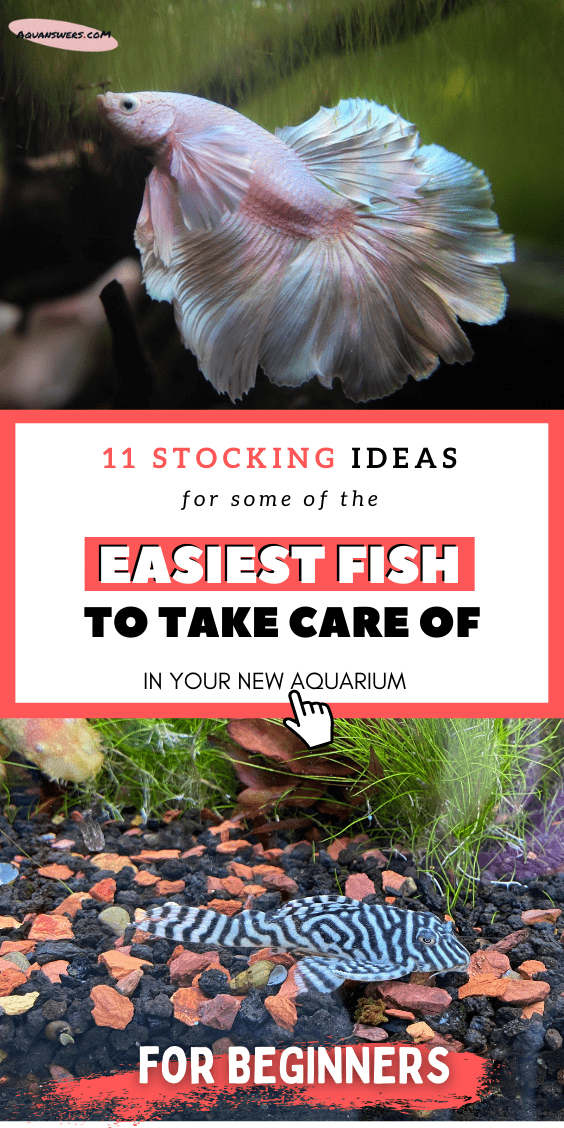
This does require a certain degree of your time.



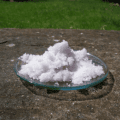


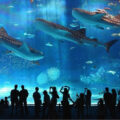


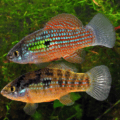
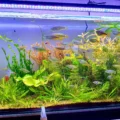

WAY TOO MANY ADDS